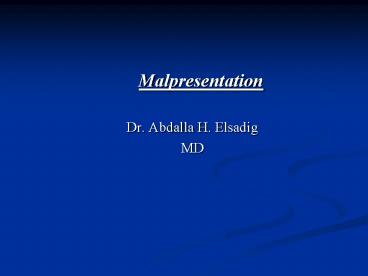Malpresentation - PowerPoint PPT Presentation
1 / 34
Title:
Malpresentation
Description:
Malpresentation Dr. Abdalla H. Elsadig MD Definitions Presentation: Is the lowermost part of the fetus occupying the lower uterine segment ( cephalic, breech, hand ... – PowerPoint PPT presentation
Number of Views:991
Avg rating:3.0/5.0
Title: Malpresentation
1
Malpresentation
- Dr. Abdalla H. Elsadig
- MD
2
Definitions
- Presentation
- Is the lowermost part of the fetus occupying
the lower uterine segment ( cephalic, breech,
hand, cord etc). - Malpresentation
- includes all presentations other than
cephalic.
3
Why malpresentation?
- In vertex presentation the presenting part is a
typical sphere (9.5 X 9.5 cm) this sphere will
allow - Production of equal uterine contraction ?
efficient uterine contractions. - Production of equal cervical dilatation ? well
fitting presenting part. - The membrane remain intact for a long time (6-8
cm). - The cord will not prolapse.
- In malpresentation the presenting part is
irregular, not fitting well to the cervix ?
complications during labour.
4
Breech Presentation
- Incidence at term 3-4, at 32 weeks 15 and at
28 weeks 20. - Types of breech
- extended or frank (60-70) the thighs are flexed
at hip joints and the legs are extended the knee
joints. - Complete or flexed (25) The thighs and legs are
flexed at hip and knee joints - Incomplete (10) The fetal foot or knee is the
lowermost presenting part
5
Etiology of breech presentation
- Feto-maternal factors
- Preterm delivery.
- Placenta praevia
- Multiple gestation
- Previous history of breech delivery.
- Polyhydramnios/oligohydramnios.
- Preterm delivery (major reason)
- Maternal factors
- Uterine anomalies bicornate
- Pelvic mass fibroids ovarian...
- Anticonvulsant therapy.
- Drug /alcohol abuse.
- Fetal factors
- IUGR/death.
- Congenital anomalies (esp. CNS)
- - anencephaly/hydrocephalus
- - Myelomeningocele.
- - prader-Willi syndrome
6
Diagnosis of breech presentation
- Abdominal palpation
- Fetal heart auscultation
- Ultrasound
- Vaginal examination
- Frank breech
- - Ischial tuberosities, the sacrum and anus are
palpable - Complete breech
- - Feet are felt along side the buttock.
- Footling
- - foot or knee is presenting
7
Management of breech presentation
- Antenatal management
- Fetal an d maternal assessment.
- External cephalic version.
- Breech delivery
- When? (Time of delivery)
- Term/preterm delivery.
- How? (Mode of delivery)
- Vaginal delivery
- Spontaneous breech delivery
- Assisted breech delivery
- Breech extraction
- Caesarean section
8
Antenatal management
- External cephalic version
- Benefits 97.5 success rate.
- Indications uncomplicated breech presentation
after 37 weeks gestation. - Absolute contraindications
- - multiple pregnancy APH
- - Ruptured membrane.
- - fetal abnormalities.
- - cord around the neck.
- Relative contraindications
- - previous C/S maternal disease.
- - maternal obesity BMI gt 20 of the ideal.
- Risks of ECV
- Procedure of ECV
9
Vaginal breech delivery
- Criteria
- Frank or complete breech presentation with
gestational age gt 36 weeks. - Estimated fetal weight of 2.5-3.5 kg.
- flexed fetal head. Extended head (due to nuchal
cord, fundal placenta, neck muscle spasm, uterine
abnormalities) associated with gt 90 poor
prognosis. - Adequate maternal pelvis (Multiparous).
- No other obstetric complications previous C/S,
PET, diabetes, IUGR,..etc. - Preferably epidural analgesia.
- Well trained staff and equipped hospital.
10
Procedure of breech delivery
- Types of vaginal breech delivery
- Spontaneous breech delivery
- Assisted breech delivery
- Breech extraction
11
Procedure of breech delivery
- First stage of labor
- - maternal and fetal
- monitoring
- C/S if failure of progress
- or Fetal distress
- - Anaethesia (epidural).
- - Oxytocin (? No)
12
Procedure of breech delivery
- Second stage of labor
- -lithotomy position episiotomy
- Spontaneous up to umbilicus
- Rotation to sacro-anterior.
- pressure on popliteal fossa.
- Cord is brought down.
- Allow fetus to hang till to
- see posterior scapular
- Deliver anterior schoulder or
- Lovsets manoevre.
13
Procedure of breech delivery
Delivery of posterior arm
14
Procedure of breech delivery
Delivery of the head - Mauriceau-Smellie-Veit mane
uver
15
Procedure of breech delivery
Delivery of the head Forceps delivery
16
Complications of breech delivery
- Fetal complications
- Intracranial haemorrhage
- hypopiturarism.
- Medullary coning
- spinal cord severance.
- Brachial plexus injury
- fracture of long bone
- rupture of internal organs
- amage to male genitalia .
- Damage to mouth and pharynx.
- Occipital diastasis impaction of occipital bone
over pubic bone in second stage ? separation of
occipital bone , cerebellum damage, brain tissue
herniation through foramen magnum, stillbirth or
ataxic cerebral palsy. - Maternal complications
- Soft tissue injuries
- Haemorrhage.
- infections
17
- A real Slides For vaginal Breech Delivery
18
No action
19
No action
20
episiotomy
21
episiotomy
22
Perineum support
23
(No Transcript)
24
(No Transcript)
25
Buttocks delivery
26
Buttocks delivery
27
Legs delivery
28
Let baby to hang on weight
29
Anterior arm delivery
30
posterior arm delivery
31
Burn-Marshal manoeuvre
32
Burn-Marshal manoeuvre
33
Burn-Marshal manoeuvre
34
Third stage of labour































